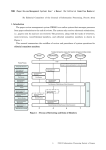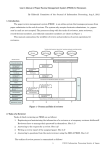Download Paper Review Management System (PRMS)User`s Manual(for
Transcript
Paper Review Management System (PRMS)User’s Manual(for Chiefs) By Editorial Committee of the Journal of Information Processing, Nov.19, 2012 1. Introduction The Paper Review Management System (PRMS) is an online system that manages processes from paper submission to the end of reviews. The system only accepts electronic submissions, i.e., papers sent by mail are not accepted. The processes along with the tasks of reviewers, meta-reviewers, record-decision-members, and editorial committee members are shown in Figure 1. This manual summarizes the workflow of review and procedures of system operations for chiefs. Figure 1: Process of Reviewing and Roles of Members 2. Tasks of chiefs Tasks of chiefs reviewing PRMS is as follows: 1. Select a decision approver (See Section 3.1) 2. Set up an online meeting (See Section 3.2) 3. Accept/Reject (Request for modification) the reports by reviewers and the meta-reviewer. (See Section 3.3) 4. Join the discussion at the online meeting (See Section 3.4) The remainder of this manual summarizes each part of processes and how to operate the system. 1 Ⓒ2012 Information Processing Society of Japan 3.1.Selection of decision approver Figure 2: Selection of Decision Approver A decision approver is selected for each paper from the chief and his/her deputies. The chief and deputy chiefs, if not selected as a decision approver, join in making decisions as committee members. See “PRMS manual for committee members” for the details of system operations for committee members. (URL) The IPSJ secretariat assigns a role of decision approver to a chief. The chief decides whether he or she will accept the assignment, or assigns the role to one of the deputies. The deputy also decides whether he/she accept the assignment. The following shows the procedure in detail: (a) You can find a paper that has not been browsed among “assigned papers” when you log in to PRMS. (See Figure 3(a)) You will be asked whether you access to the paper or not when you select to see “detailed information”. (See Figure 3(b)). The chief assigned the role of decision approver must select to “access to the paper” in this screen. (b) PRMS shows the details of the paper. (See Figure 3(c)). You do not have to do anything further if you accept the assignment of decision approver. Otherwise, select “assigns a decision approver” shown in Figure 3(d). (c) Find candidates of decision approver by using “search for record-decision-member”. (See Figure 4(a).) You can view the assigned paper after you choose one of the candidates. (See Figure 4(b)). Select “decline to view this paper” if there is a conflict of interest regarding the paper. 2 Ⓒ2012 Information Processing Society of Japan (a) (b) (c) (d) Figure 3: Acceptance / Rejection to be decision approver (d) Confirmation screen will be shown. (See Figure 4(c)). Confirm the process by selecting “Send”. An e-mail that requests to be a decision approver (shown in Figure 5) will be sent to the selected candidate. (e) The selected candidate can also accept / reject the request by following the same process. 3 Ⓒ2012 Information Processing Society of Japan (a) (b) (c) Figure 4: Assignment of decision approver 4 Ⓒ2012 Information Processing Society of Japan Subject:[JIP: Request] (Receipt no.: 12-XX004) Decision Approver Dear Name, You have been assigned to be decision approver of the following paper. 12-XX004 Please access the following URL to login to the system and open the review results. LOGIN_URL Sincerely yours, Editorial Committee of Journal of Information Processing Information Processing Society of Japan (IPSJ) Figure 5: Email to decision approver 5 Ⓒ2012 Information Processing Society of Japan 3.2. Setting Up Online Meeting Figure 6: Setting Up Online Meeting An email requesting a decision (shown in Figure 7) will be sent to the decision approver after all reviews by the reviewers and meta reviewer are entered. Log into the system by accessing the URL shown in the email and start the decision process. The decision approver can choose from the following two options: z The decision process WITHOUT an online discussion z The decision process WITH an online discussion If the decision approver chose not to use online discussion for this paper, enter the approval results by clicking “Acceptance of the report/Need to amend the report” in Figure 8 at appropriate time. In this case, the deadline of an online discussion must not be set. If the design approver did choose to use online discussion for this paper, set the deadline of an online discussion by clicking “Setting the schedule of an online discussion” in Figure 8. Once the start and end date of the online discussion are entered and saved, a new discussion thread is created on a BBS (“discussion threads” in PRMS). The name of the thread for online discussion is “Xth Online Discussion (YYYY/MM/DD – YYYY/MM/DD)”. The committee members participating in the discussion can use this thread, in addition to the thread for general communication named “Discussion thread (editor in chief/committee member/meta reviewer can access this thread)”. The members should discuss the review results during the time period specified by the start and end date. The start and end date cannot be set to a past date. Preferred deadlines are as follows: - 7 (or more) days after starting of the discussion if the decision by the meta-reviewer was “accept”. - 7 (or more) days after starting of the discussion if the decision by the meta-reviewer was “reject”. - 5 days after starting of the discussion if the decision by the meta-reviewer was “conditional accept”. (You need not care about the day of editorial board meetings because the secretariat sends the review results directly to authors immediately after the decision approver makes a decision.) 6 Ⓒ2012 Information Processing Society of Japan For an “accepted” or “rejected” paper, the deadline is recommended to be set to the date before the next editorial board meeting, so that the final decision can be approved by the board in a timely manner. For a “conditionally accepted” paper, the review results can be returned to authors as soon as the decision approver enters the approval. The deadline needs be set to one or more days before the day of the next editorial board meeting in order to allow the decision approval (by the decision approver) and the final decision (at the editorial board meeting) to be made on the same day. For special issues, give first priority to the schedule of the special issue when setting the deadline. The decision approver, committee members, and meta reviewer participate in the discussions. If necessary, the committee can contact reviewers for any question as long as their neutrality is protected. The email that notifies the members of the start of the online discussion is sent at midnight of the start date. If the start date was set to the current date, the email is sent out immediately. At midnight of the following day of the end date, another email is sent to notify the end of the discussion. The decision approver can also choose to terminate the discussion earlier, in which case the email notifying the termination of the discussion is sent to the members. 7 Ⓒ2012 Information Processing Society of Japan Subject:[JIP: Request] (Receipt no.: 12-XX003) MetaReview Decision Dear Name: Please access to the following URL and make your decisions as the decision approver about the paper (Receipt no.: 12-XX003). URL There are two ways to make your decisions. - Decision WITHOUT an online discussion - Decision WITH an online discussion If you do not want to hold an online discussion, do not set the duration of the online discussion. You can complete the decision approval of the paper in the [Acceptance of the report/Need to amend the report] screen immediately. If you want to hold an online discussion, please set the duration of the online discussion. After fixing the start and end date, a BBS for the discussion is created. The name of the BBS is "Xth Online Discussion(YYYY/MM/DD-YYYY/MM/DD)". After the deadline has passed, complete the decision approval of the paper in the [Acceptance of the report/Need to amend the report] screen by referring to the discussion on the bulletin board. The screens of the BBS and [Acceptance of the report/Need to amend the report] can be accessed from the [Detailed information] screen for the paper. Sincerely yours, Editorial Committee of Journal of Information Processing Information Processing Society of Japan (IPSJ) Figure 7: Email to request for decision approval 8 Ⓒ2012 Information Processing Society of Japan Figure 8: Set up the duration of online meetings 9 Ⓒ2012 Information Processing Society of Japan Subject: First Online Discussion(2012/11/08-2012/11/08) has started (Receipt no.: 12-XX003) Dear Name, Online discussion has started. Please access the following URL to join the discussion about the decision. URL Sincerely yours, Editorial Committee of Journal of Information Processing Information Processing Society of Japan (IPSJ) Figure 9: Email notification of starting of online meeting 10 Ⓒ2012 Information Processing Society of Japan 3.4. Online Meeting Figure 10: Online Meeting After the review and meta-review reports are posted, a decision approver (group chair or vice chair in most cases) starts the approval process. If an online meeting decides to be held, the duration of the online discussion is set. The committee members (including a chief and deputy chiefs), the decision approver, meta reviewers, (and guest members in some cases) discuss to make decisions based on (meta-)review reports on the online meeting. For the sake of fairness, reviewers do not participate in the discussions, but the editorial committee can ask questions or ask for corrections to reviewers if required. The chief participates in the discussion as a decision approver or a committee member. Discussions must be concluded before the set deadline. Questions to reviewers or meta-reviewers should be made via the BBS. Screens when (a) accessing to the BBS, (b) browsing a thread, and (c) making posts to the BBS are shown in Figure 11. Figure 11 (a) shows the threads related to some paper. The thread named “Xth Online Discussion (YYYY/MM/DD – YYYY/MM/DD)” is used for the online discussion. This thread is created automatically when the decision approver sets the duration of the discussion. In addition, there are threads for general communication in the committee members, for making questions to reviewer-1, and for making questions to reviewer-2. A reviewer is notified by email when a question is posted to the thread corresponding to that reviewer. The decision approver can make decisions after the deadline. An example screenshot is shown in Figure 13. Select to approve/request revision for each of the review records and account record. The status of review records (or account records) are changed from “fixed” to “possible to edit” if “reject (request for corrections)” is selected. For papers for which decisions are made, an inquiry is sent to the authors, or the decision record is sent to editorial boards for final decisions. After the final decision is made, it will be sent to the 11 Ⓒ2012 Information Processing Society of Japan meta-reviewers and reviewers. The IPSJ secretariat simultaneously sends the notification of review results to the authors. 12 Ⓒ2012 Information Processing Society of Japan (a) (b) (c) Figure 11: Screenshots of BBS 13 Ⓒ2012 Information Processing Society of Japan [JIP: Request] (Receipt no.: 12-XX003) Request to Update Review Dear Name Thank you for your help in the review process. The editorial committee is now requesting to update your review entry. Please check the details of the request by accessing the online discussion thread. The URL will be sent in a separate email. 12-XX003 PAPER_TITLE Sincerely yours, Editorial Committee of Journal of Information Processing Information Processing Society of Japan (IPSJ) Figures 12: Question email to reviewers Figure 13: Decisions by Decision Approver 14 Ⓒ2012 Information Processing Society of Japan 4. Notes on other issues ・When you forget your password: You can set a new password in the login screen. Click “If you forget your ID or password”, and a dialogue box to input your email address will appear. You will receive an email (shown in Figure 15) to the input address for resetting your account. A dialogue box to set your new password will appear if you click the URL shown in the email. Note that the URL is valid only for 10 minutes just after the email is sent. Subject:[JIP: Notification] Reset password 23 Mar 2012 Dear Name You can reset your password at the following URL. Note that this page will no longer be valid after 10 minutes have passed since this email was sent to you. If you have not requested to reset your password, please contact the IPSJ office ([email protected]). Login page: URL Sincerely yours, Editorial Committee of Journal of Information Processing Information Processing Society of Japan (IPSJ) Figure 15: Email for resetting passwords ・Useful functions for work management: You can see the list of papers that need to be processed if you click ‘assigned papers’ or ‘unviewed papers’ in the screen immediate after log-in. (See Figure 16.) 15 Ⓒ2012 Information Processing Society of Japan Figure 16: Work Management Screens 16 Ⓒ2012 Information Processing Society of Japan




























